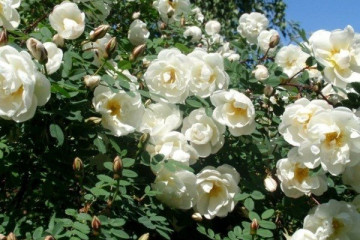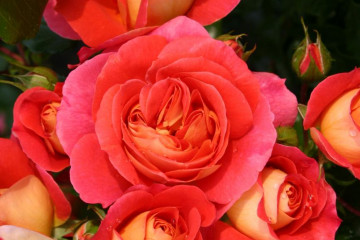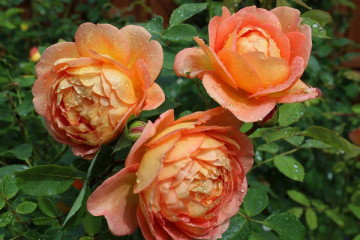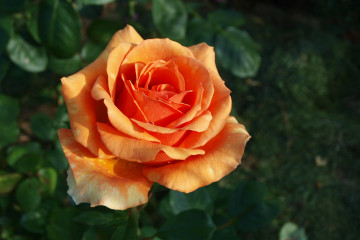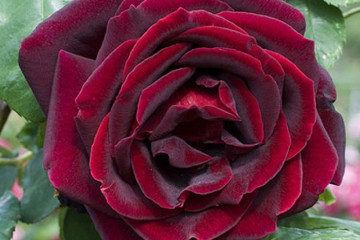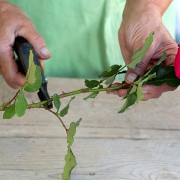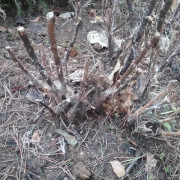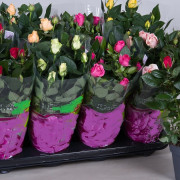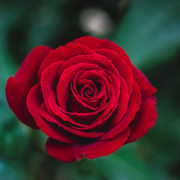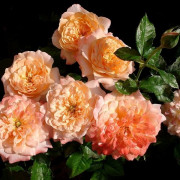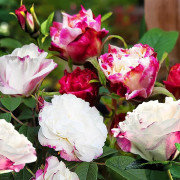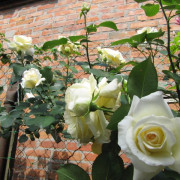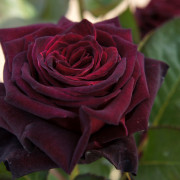Rose Hello (Hello) - description of the shrub from the series "Farniente"
Content: [Hide]
Hello Rose inherited the best qualities of decorative roses. It is distinguished by abundant and long-lasting flowering, rich green color. Low shoots spread along the ground, look good on low supports.
Rose Hello (Hello)
The variety is part of the "farniente" (lazy) series of the Meilland rose-growing company, France. Meilland breeders introduced the rose to flower growers in 2002. Then the industrial production of planting material began.
Brief description, characteristic
Rose Hello belongs to the ground cover, creeping varieties, forms a densely doubled dark red bud. During the growth period, a spherical bush from 30 to 50 cm is formed. Half-stubs (tied to small supports) reach a meter height. The diameter of the flowers is up to 6 cm, they are collected in inflorescences from 15 to 25 pieces.
Advantages and disadvantages of the variety
Halloween bush roses:
- do not fade or fade;
- resistant to return frost;
- have foliage that is rarely affected by disease;
- grow well in Siberia and the Urals.
The only drawback is that you need to constantly remove wilting flowers.
Use in landscape design
Horizontally growing shoots are often tied to supports, forming flower cascades. Rose Hello is appropriate in any corner of the garden: in flower beds, rocky areas. The shrub is often referred to as the "purple carpet".
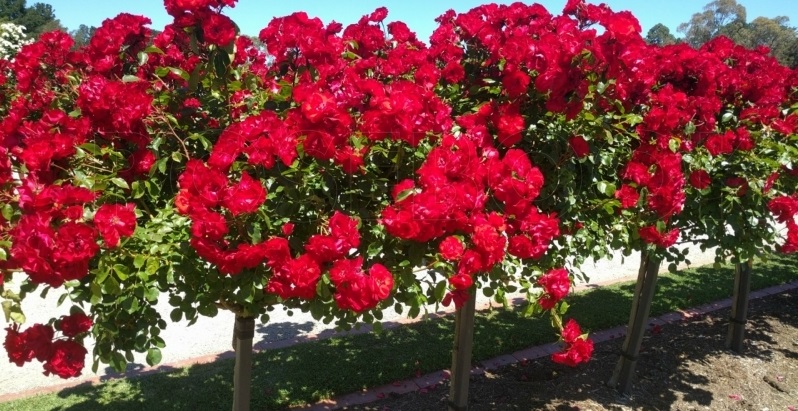
Climbing roses are often grafted onto stem varieties, a stem is formed. It looks beautiful in single and curb planting
Growing a flower, how to plant it in open ground
The correct planting determines how quickly a full-fledged bush will form, its survival rate.
In what form is the landing
Rose seeds have low germination. For planting, layering and rooted cuttings are more often used.
What time is the boarding
Spring planting is carried out in April, autumn planting in early October.
Location selection
The plant needs a soil fertile, rich in organic matter, slightly acidic. Rose loves dry areas where water does not accumulate. It is desirable that the site be shaded and well ventilated from midday.
How to prepare the soil and flower for planting
The soil is loosened, enriched with universal complex fertilizers. At the seedling, the shoots are shortened to 25-30 cm, the roots are soaked in water for up to 2 hours.
Planting procedure step by step
Hello adapts quickly if planting rules are followed. Process description:
- Dig a narrow hole up to 60 cm deep.
- Drainage is laid at the bottom with a layer of 10 cm.
- A mound of fertile soil is made from above, the roots are melted on it.
- Set the seedling so that the root collar deepens by 2–2.5 cm.
- They fill the void with soil, crush it.
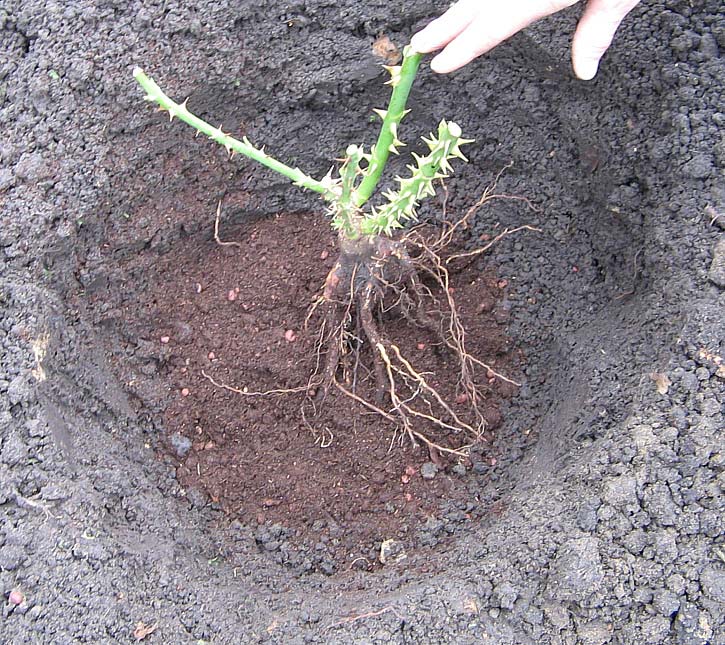
So it is correct to place the seedling in the planting hole. It remains to fill it with prepared soil
Rose Hello: plant care
The main rules of care are cleaning the land from weeds, loosening, mulching.
Watering rules and humidity
Water the plant no more than twice a week. It is advisable to avoid cold tap water, it is better to use rainwater. Up to 15 liters of water is poured onto the bush. Watering is reduced with the onset of the first frost.
Top dressing and soil quality
In the spring, nitrogen is introduced, during the flowering period, minerals are introduced at a 3-week interval in the ratio: phosphorus - 2 parts, potassium, nitrogen - one at a time. The last feeding is done in September. Later, the plant should rest. The recommended soil acidity is 5.5–6.5.
Pruning and replanting
Pruning stimulates the formation of buds, it is carried out as soon as the buds wake up. In annual bushes, the first layer of buds is completely cut off. Of the August leaves, up to 3 are left on one shoot.
Standard bushes are wrapped in spunbond or dense film. The barrel is protected from sunburn with a cloth.
Features of wintering a flower
A wire frame is installed around the bush, a shelter is made of spruce branches, dry branches or covering material. The air gap will protect the lashes from severe frosts.
Blooming rose
The main advantage of the flower is abundant long flowering, the flowers gradually change color from dark red to rich crimson or cherry.
A period of activity and rest
The first buds appear in June, every 10 days the flower rests for two or three days, then again releases inflorescences. The activity continues until November.
Care during and after flowering
During flowering, the rose needs moisture and nutrients. With the onset of frost, watering is reduced, pruning is carried out, and shelters are prepared.
What to do if it does not bloom, possible reasons
When the branches freeze, flowering is delayed up to two weeks, pruning of the affected shoots is carried out to stimulate branching.
The bush does not release buds if the soil is too alkaline. Then slurry or brown peat is introduced. When exposed to direct sunlight on hot days, the bush experiences stress, stops budding. When the soil is dry, the number of flowers is noticeably reduced.
Flower propagation
Hello rose reproduces well by layering, dividing the bush. Seeds and budding (grafting) are rarely used for breeding. Root-viable plants that grow after damage to the aerial part of the bush are transferred to a permanent place.
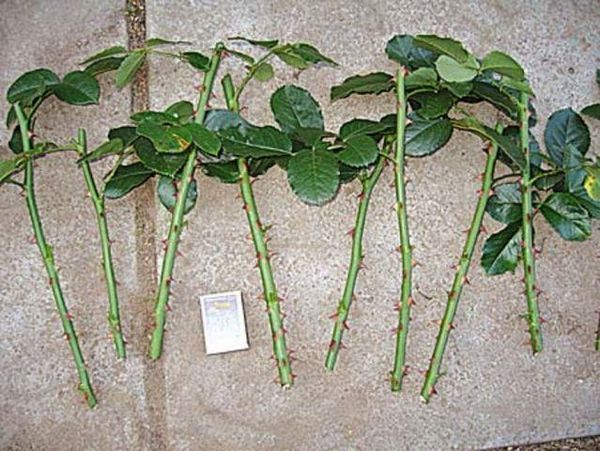
Cuttings, prepared for rooting, are placed in a solution of a growth stimulator, and after the formation of a root bundle, they are rooted in the ground
When is it produced
Layers are formed in summer, outlets are planted before winter. Cuttings are cut in the spring, rooted until autumn, or left in the apartment until next spring.
Detailed description
For layering, the branches are pinned to the ground to form rosettes.Cuttings are cut from two-year-old shoots of adult bushes at the age of at least 5 years. The cut is made oblique, the bottom of the branch is cut crosswise so that moisture is better absorbed.
Diseases, pests and ways to control them
Hello ground cover rose is rarely a hassle. It is resistant to powdery mildew, black spot, rust, and other fungal diseases. When young bushes and weakened plants are affected, one treatment is usually enough.
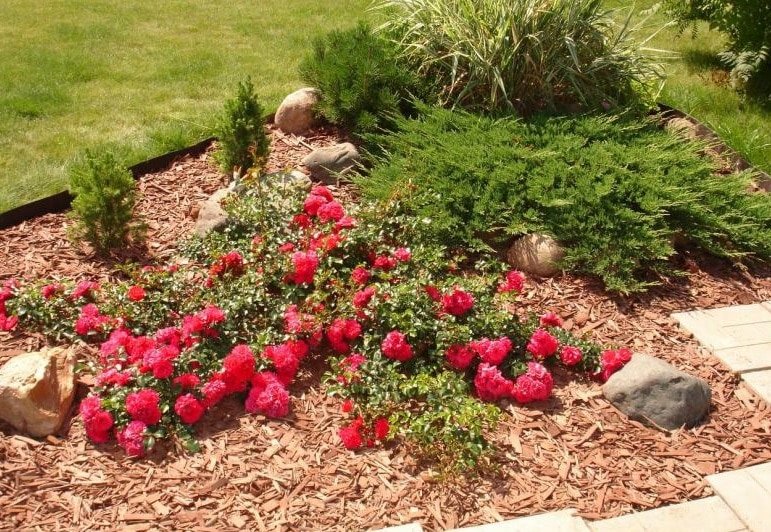
A Halloween rose has stems that grow horizontally. The soil under them is abundantly mulched with wood waste
When attacked by insects, plant or chemical insecticides and acaricides are used. Aphids love roses, in this case, additionally, you need to remove black earth ants. Greens infect the larvae of the rose sawfly caterpillars. If the leaves curl, the buds crumble, it means that a spider mite attacked.
Ground cover roses are ideal for garden decoration. Standard varieties are planted along the paths, on flower beds, slopes, rocky areas - half-stem or creeping bushes. Hello goes well with other types of roses, conifers.


